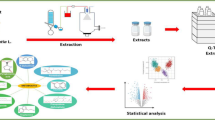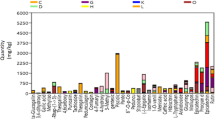Abstract
Haematocarpus validus (Miers) Bakh. f. ex Forman, a lesser-known fruit and medicinal plant of high nutraceutical and medicinal value, is used as anti-arthritic, hepatoprotective, and anti-inflammatory agents in ethnomedicine. Metabolome studies in H. validus are a virgin area of research and here we report the spectra of non-volatiles present in the methanolic leaf and fruit extract, using high-resolution liquid chromatography-mass spectrometry. Furthermore, the alkaloid sinomenine was quantified using high-performance thin layer chromatography spectrodensitometric analysis owing to its pharmacological importance as anti-arthritic and anti-inflammatory drug. Electrospray ionization with protonation in positive mode was selected for the analysis and the spectral data was interrogated using MassHunter software. A total of 40 compounds were identified from leaf and fruit samples and the major classes of compounds identified were alkaloids, terpenoids, steroids, tripeptides, vitamins, and related compounds. For separation and quantitation of sinomenine, chloroform:methanol:water (60:30:6.5, v/v) was used as the mobile phase and sinomenine hydrochloride as reference compound. The analysis confirmed the presence of sinomenine in both non-defatted and defatted methanolic leaf extract with quantities 45.73 and 26.02 mg/100 g dry weight, respectively. H. validus is a non-conventional source of sinomenine, the anti-arthritic and anti-inflammatory alkaloid. Sinomenine detected in this study supports the ethnomedicinal uses of H. validus as an anti-arthritic agent. Further study is needed to elucidate the underlying molecular mechanism of its anti-arthritic attributes as well as the corresponding structure–activity relationships.







Similar content being viewed by others
Data availability
All the data of this study are transparent and available upon request.
Change history
12 April 2024
A Correction to this paper has been published: https://doi.org/10.1007/s00210-024-03084-w
References
Abbasoglu U, Sener B, Gunay Y, Temizer H (1991) Antimicrobial activity of some isoquinoline alkaloids. Arch Der Pharmazie 324:379–380. https://doi.org/10.1002/ardp.19913240612
Alex, BK (2018) Bioprospecting of the wild edible and underutilized plant Haematocarpus validus (Miers) Bakh.f. ex Forman. Ph. D. Dissertation, Sam Higginbottom University of Agriculture, Technology and Sciences, Allahabad, India. http://krishikosh.egranth.ac.in/handle/1/5810058530
Alex, BK, Koshy, EP, Jacob, S, Thomas, G (2021) Wild edible fruit crop Haematocarpus validus (Miers) Bakh.f. ex Forman (Khoon phal): a novel source of nutraceuticals. J Food Sci Technol. https://doi.org/10.1007/s13197-021-04997-7
Backer, CA, van den Brink, RCB (1963) Flora of Java, vol. 1. P. Noordhoff, Groningen, Netherlands, pp 151–159. https://books.google.co.in/books?id=I1FCAQAAIAAJ
Barbosa-Filho, JM, da-Cunha, EVL, Gray, AI (2000) Alkaloids of the Menispermaceae. In: Cordell, G. A. (ed.) The Alkaloids: Chemistry and Biology. Vol. 54, Chapter I. San Diego: Academic Press Inc., pp. 1–190. https://doi.org/10.1016/S0099-9598(00)54002-4
Bohra, P., Waman, A. A. and Roy, S. D. Khoon phal (Haematocarpus validus (Miers.) Bakh. F. Ex Forman). CRP-AB/Underutilized Species/T.B.-01, ICAR-CIARI, Port Blair., 2016, pp. 1–8. https://www.researchgate.net/profile/Sibnarayan-Dam-Roy/publication/299330626_Khoon_Phal_Haematocarpus_validus_Miers_Bakh_F_ex_Forman/links/56f0d05d08aeedbe3ce44300/Khoon-Phal-Haematocarpus-validus-Miers-Bakh-F-ex-Forman.pdf
Bohra P, Waman AA, Basantia D, Devi HL, Reang E (2018) Domestication and conservation efforts in Haematocarpus validus (Miers.) Bakh. f. ex Forman (Menispermaceae): an underutilized fruit species and natural colourant. Curr Sci 115(6):1098–1105. https://doi.org/10.18520/cs/v115/i6/1098-1105
Chen DP, Wong CK, Leung PC, Fung KP, Lau CB, Lau CP, Li EK, Tam LS, Lam CW (2011) Anti-inflammatory activities of Chinese herbal medicine sinomenine and Liang Miao San on tumor necrosis factor-α-activated human fibroblast-like synoviocytes in rheumatoid arthritis. J Ethnopharmacol 137(1):457–468. https://doi.org/10.1016/j.jep.2011.05.048
Cuthbertson DJ, Johnson SR, Piljac-Zegarac J, Kappel J, Schafer S, Wust M, Ketchum REB, Croteau RB, Marques JV, Davin LB, Lewis NG, Rolf M, Kutchan TM, Soejarto DD, Lange BM (2013) Accurate mass-time tag library for LC/MS-based metabolite profiling of medicinal plans. Phytochem 91:187–197. https://doi.org/10.1016/j.phytochem.2013.02.018
Dasgupta S, Ray AB, Bhattacharya SK, Ray R (1979) Constituents of Pachygone ovate and pharmacological action of its major leaf alkaloid. J Nat Prod 42:399–406. https://doi.org/10.1021/np50004a007
Deng F, Ma YX, Liang L, Zhang P, Feng J (2018) The pro-apoptosis effect of sinomenine in renal carcinoma via. inducing autophagy through inactivating PI3K/AKT/mTOR pathway. Biomed Pharmacother 97:1269–1274. https://doi.org/10.1016/j.biopha.2017.11.064
DeWet H, VanHeerden FR, VanWyk BE (2004) Alkaloids of Antizoma angustifolia (Menispermaceae). Biochem Syst Ecol 32(12):1145–1152. https://doi.org/10.1016/j.bse.2004.04.003
DeWet H, VanHeerden FR, VanWyk BE (2005) Alkaloids of Antizoma miersiana (Menispermaceae). Biochem Syst Ecol 33(8):799–807. https://doi.org/10.1016/j.bse.2004.12.014
Hajra PK, Rao PSN, Mudgal V (1999) Flora of Andaman and Nicobar Islands (Ranunculaceae to Combretaceae), vol. 1. Botanical Survey of India, India. https://books.google.co.in/books?id=FUpdzwEACAAJ
Holmes, HL (1952) Sinomenine. In: Manske, R. H. F., Holmes, H. L., (eds.) The Alkaloids: Chemistry and Physiology Vol. II, Chapter IX. New York (NY): Academic Press Inc., pp. 219–260. https://doi.org/10.1016/S1876-0813(08)60026-3
http://www.agilent.com/chem/metabolomics. Accessed 25 Jan 2018
http://www.hmdb.ca/metabolites/HMDB60351. Accessed 25 Jan 2018
https://www.drugbank.ca/drugs/DB00749. Accessed 25 Jan 2018
Idrus NM, Breit KR, Thomas JD (2017) Dietary Choline levels modify the effects of prenatal alcohol exposure in rats. Neurotoxicol Teratol 59:43–52. https://doi.org/10.1016/j.ntt.2016.11.007
Kang, JH, Kim, DJ, Choi, BK, Park, JW (2017) Inhibition of malodorous gas formation by oral bacteria with cetylpyridinium and zinc chloride. Arch Oral Biol, Article published online: 28/09/2017. https://doi.org/10.1016/j.archoralbio.2017.09.023
Keller WJ, McLaughlin JL, Brady LR (1973) Cactus alkaloids XV: β-phenethylamine derivatives from Coryphantha macromeris var runyonii. J Pharmaceut Sci 62(3):408–411. https://doi.org/10.1002/jps.2600620311
Khatun, MJM, Rahman, MM, Rahim, MA, Mirdah, MH (2014) Study on the taxonomy and nutritional status of Lalgula (Haematocarpus validus): a promising endemic ethnic fruit of Bangladesh. Int J Sust Agri Technol, 10(2), 1–4. https://scholar.google.com/scholar?oi=bibs&cluster=11085809882841462509&btnI=1&hl=en
Kumar, K, Kumar, B, Selvun, T, Sajibala, B, Jairaj, RSC, Mehrotra, S Pushpangadan, P (2006) Ethnobotanical heritage of Nicobarese tribe. J Econ Taxon Bot, 30, 331–348. https://www.researchgate.net/publication/315653667_Ethnobotanical_heritage_of_Nicobrese_tribe
Likhitwitayawuid K, Angerhofer CK, Chai H, Pezzuto JM, Cordell GA, Ruangrungsi N (1993) Traditional medicinal plants of Thailand. XXIII. Cytotoxic and antimalarial alkaloids from the tubers of Stephania pierrei. J Nat Prod 56:1468–1478. https://doi.org/10.1021/np50099a005
Medeiros MAA, Nunes XP, Barbosa-Filho JM, Lemos VS, Pinho JF, Roman-Campos D, deMedeiros IA, Araujo DAM, Cruz JS (2009) (S)-reticuline induces vasorelaxation through the blockade of L-type Ca2+ channels. Naunyn-Schmiedeberg’s Arch Pharmacol 379(2):115–125. https://doi.org/10.1007/s00210-008-0352-1
Minami H, Kim JS, Ikezawa N, Takemura T, Katayama T, Kumagai H, Sato F (2008) Microbial production of plant benzylisoquinoline alkaloids. Proceed Nat Acad Sci, USA 105(21):7393–7398. https://doi.org/10.1073/pnas.0802981105
Nair JJ, Bastida J, Viladomat F, vanStaden J (2012) Cytotoxic agents of the crinane series of Amaryllidaceae alkaloids. Nat Prod Commun 7(12):1677–1688. https://doi.org/10.1177/1934578X1200701234
Nawai S, Ma C, Nakamura N, Hattori M, Kurokawa M, Shiraki K, Kashiwaba N, Ono M (1999) Anti-herpes simplex virus activity of alkaloids isolated from Stephania cepharantha. Biol Pharmaceut Bull 22(3):268–274. https://doi.org/10.1248/bpb.22.268
Pahwa N, Kumar A, Gupta S (2011) Short term clinical effectiveness of a 0.07% cetylpyridinium chloride mouth rinse in patients undergoing fixed orthodontic appliance treatment. Saudi Dent J 23(3):135–141. https://doi.org/10.1016/j.sdentj.2011.03.001
Polya G (2003) Anti-inflammatory, antioxidant and antidiabetic plant compounds. Chapter 14. In: Biochemical targets of plant bioactive compounds: a pharmacological reference guide to sites of action and biological effects. CRC Press, London. https://doi.org/10.1201/9780203013717
Qian L, Xu Z, Zhang W, Wilson B, Hong JS, Flood PM (2007) Sinomenine, a natural dextrorotatory morphinan analog, is anti-inflammatory and neuroprotective through inhibition of microglial NADPH oxidase. J Neuroinflammation 4:23. https://doi.org/10.1186/1742-2094-4-23
Sasikumar R, Das D, Saravanan C, Deka SC (2020) GC-HRMS screening of bioactive compounds responsible for antimicrobial and antioxidant activities of blood fruit (Haematocarpus validus Bakh. F. Ex Forman) of North-East India. Arch Microbiol 202(10):2643–2654. https://doi.org/10.1007/s00203-020-01985-x
Sasikumar R, Kambhampati V, Saravanan C, Sankar CD (2021) Physicochemical characterization and mass modeling of blood fruit (Haematocarpus validus)–an underutilized fruit of northeastern India. Int J Fruit Sci 21(1):12–25. https://doi.org/10.1080/15538362.2020.1848752
Singh B, Bedi YS (2016) Rediscovery, taxonomic history and extended enumeration of Haematocarpus validus Bakh.f. ex Forman (Menispermaceae) to Indo-Myanmar biodiversity hotspot. Nat Acad Sci Lett 39(5):383–387. https://doi.org/10.1007/s40009-016-0483-8
Singh, S. S., Pandey, S. C., Srivastava, S., Gupta, V. S., Patro, B. and Ghosh, A. C. (2003) Chemistry and medicinal properties of Tinospora cordifolia (Guduchi). Ind J Pharmacol, 35, 83–91. https://ijp-online.com/article.asp?issn=0253-7613;year=2003;volume=35;issue=2;spage=83;epage=91;aulast=Singh;type=0
Springob, K, Kutchan, TM (2009) Introduction to different classes of Natural Products. In: Osbourn, A. E. and Lanzotti, V. (eds.) Plant derived Natural Products: Synthesis, Function and Application. Springer, pp. 3–50. https://doi.org/10.1007/978-0-387-85498-4
Wagner, H, Bauer, R, Melchart, D, Xiao, P, Staudinger, A (2011) Caulis sinomenii. Qingfengteng. In: Chromatographic fingerprint analysis of herbal medicines. Thin-layer and high performance liquid chromatography of chinese drugs, vol. 1. SpringerWien, New York (NY), pp 369–380. https://doi.org/10.1007/978-3-7091-0763-8
Wolfender JL (2009) HPLC in natural product analysis: the detection issue. Planta Med 75(7):719–734. https://doi.org/10.1055/s-0028-1088393
Yamasaki, H (1976) Pharmacology of sinomenine, an anti-rheumatic alkaloid from Sinomenium acutum. Acta Med Okayama, 30(1), 1–20. https://ousar.lib.okayama-u.ac.jp/31433
Zeisel SH (1992) Choline: an important nutrient in brain development, liver function and carcinogenesis. J Am Colle Nutri 11(5):473–481. https://doi.org/10.1080/07315724.1992.10718251
Zeisel SH, daCosta KA (2009) Choline: an essential nutrient for public health. Nutri Rev 67(11):615–623. https://doi.org/10.1111/j.1753-4887.2009.00246.x
Zhao XX, Peng C, Zhang H, Qin LP (2012) Sinomenium acutum: a review of chemistry, pharmacology, pharmacokinetics and clinical use. Pharm Biol 50(8):1053–1061. https://doi.org/10.3109/13880209.2012.656847
Acknowledgements
We acknowledge Dr. T.V.R.S. Sharma (Former Director, Central Agricultural Research Institute, Port Blair, Andaman and Nicobar Islands), for kindly providing plant material for the study. Authors are thankful to The Head, Sophisticated Analytical Instrument Facility, IIT Bombay, Mumbai, for facilitating HR LC-MS analysis and to Cashew Export and Promotion Council of India (CEPCI), Kollam, Kerala, India, for providing technical support to carry out HP-TLC analysis. The authors are thankful to the Vice Chancellor, Sam Higginbottom University of Agriculture, Technology and Sciences, Prayagraj, for providing laboratory space and other necessary facilities.
Funding
The authors declare that no funds, grants or other support were received during the preparation of this manuscript.
Author information
Authors and Affiliations
Contributions
All authors contributed to the study conception and design. Blessymole K. Alex: Materials preparation, investigation, data collection and analysis, visualization, data interpretation, writing—review and editing, illustration plotting, final draft. Uttpal Anand: writing—review and editing, data analysis, reviewing illustration and editing, visualization, arranged references. Eapen P. Koshy: writing—review and editing, formal analysis, data collection and analysis, visualization, data interpretation, illustration plotting, overall revision. Abhijit Dey: writing—review and editing, suggestions. George Thomas: supervision, writing—review and editing, formally interpreted data, reviewing illustration and editing, visualization, critical editing, revision, suggestions. All authors have read and approved the final manuscript. The Authors declare that all data were generated in-house and that no paper mill was used.
Corresponding author
Ethics declarations
Ethical approval
Not applicable.
Consent to participate
Not applicable.
Consent for publication
The authors give consent for the publication of this study.
Competing interests
The authors declare no competing interests.
Additional information
Publisher's note
Springer Nature remains neutral with regard to jurisdictional claims in published maps and institutional affiliations.
Supplementary Information
Below is the link to the electronic supplementary material.
Rights and permissions
Springer Nature or its licensor (e.g. a society or other partner) holds exclusive rights to this article under a publishing agreement with the author(s) or other rightsholder(s); author self-archiving of the accepted manuscript version of this article is solely governed by the terms of such publishing agreement and applicable law.
About this article
Cite this article
Alex, B.K., Anand, U., Koshy, E.P. et al. Analysis of non-volatile metabolites and quantitation of the anti-arthritic alkaloid sinomenine from blood fruit (Haematocarpus validus (Miers) Bakh.f. ex Forman). Naunyn-Schmiedeberg's Arch Pharmacol 396, 2943–2955 (2023). https://doi.org/10.1007/s00210-023-02498-2
Received:
Accepted:
Published:
Issue Date:
DOI: https://doi.org/10.1007/s00210-023-02498-2




